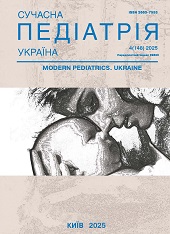Congenital spondyloepiphyseal dysplasia due to COL2A1 gene mutation
DOI:
https://doi.org/10.15574/SP.2025.4(148).169176Keywords:
spondyloepiphyseal dysplasia, children, COL2A1 gene mutationAbstract
Skeletal dysplasia is a rare genetic pathology that is a consequence of disorders of osteo-, chondrogenesis and other changes in the development and growth of epiphyseal cartilage, epiphyses, metaphyses, diaphyses of long bones and vertebral bodies, which leads to dysfunction of peripheral joints and spine in children.
Aim - to familiarize with the features of the course, clinical manifestations and diagnosis of spondyloepiphyseal dysplasia (SED) with osteoarthritis and progressive osteoporosis in childhood.
A clinical case of own observation of a child of adolescent age with complaints of difficulty walking, rapid fatigue, limping, starting pain in the joints, back during the day, limitation of function of the knee, hip, shoulder, elbow, radiocarpal joints, cervical spine, contractures of the elbow, radiocarpal joints is presented. In the presence of typical signs of the SED phenotype (short stature, specific facial features, rapid fatigue, limping, starting pain in the joints, back during the day, limitation of function of the knee, hip, shoulder, elbow, radiocarpal joints, cervical spine, contractures of the elbow, radiocarpal joints), no extraskeletal manifestations were detected in the child. During molecular genetic testing, a heterozygous variant in the COL2A1 gene (p.611G>A (p.Gly204Asp)) was identified in the patient, which is associated with bone disease and is characterized by the development of generalized osteoarthritis and systemic osteoporosis.
Conclusions. Congenital spondyloepiphyseal dysplasia in childhood can occur under the guise of rheumatic diseases without obvious laboratory activity of the inflammatory process and early development of contractures, stiffness in the joints and progressive osteoporosis. Patients require a comprehensive examination using modern laboratory, instrumental and genetic examination methods and careful differential diagnosis and involvement of a multidisciplinary team of specialists for the management of such patients.
The study was performed in accordance with the principles of the Declaration of Helsinki. Informed consent of the child's parents was obtained for the study.
The authors declare that there is no conflict of interest.
References
Barat-Houari M, Dumont B, Fabre A, Them FT, Alembik Y, Alessandri JL et al. (2016). The expanding spectrum of COL2A1 gene variants IN 136 patients with a skeletal dysplasia phenotype. Eur. J. Hum. Genet. 24: 992-1000. https://doi.org/10.1038/ejhg.2015.250; PMid:26626311 PMCid:PMC5070901
Bonafe L, Cormier-Daire V, Hall C, Lachman R, Mortier G, Mundlos S et al. (2015). Nosology and classification of genetic skeletal disorders: 2015 revision. Am. J. Med. Genet. A. 167A(12): 2869-2892. https://doi.org/10.1002/ajmg.a.37365; PMid:26394607
Girisha KM, Bhavani GS, Shah H, Moirangthem A, Shukla A, Kim OH et al. (2020). Biallelic variants p.Arg1133Cys and p.Arg1379Cys in COL2A1: Further delineation of phenotypic spectrum of recessive Type 2 collagenopathies. Am. J. Med. Genet. A. 182: 338-347. https://doi.org/10.1002/ajmg.a.61414; PMid:31755234
Jurgens J, Sobreira N, Modaff P et al. (2015). Novel COL2A1 variant (c.619G>A, p.Gly207Arg) manifesting as a phenotype similar to progressive pseudorheumatoid dysplasia and spondyloepiphyseal dysplasia, Stanescu type. Hum. Mutat. 36: 1004-1008. https://doi.org/10.1002/humu.22839; PMid:26183434 PMCid:PMC4575260
Krakow D. (2015, Jun). Skeletal dysplasias. Clin Perinatol. 42(2): 301-319. https://doi.org/10.1016/j.clp.2015.03.003; PMid:26042906 PMCid:PMC4456691
Rolvien T, Yorgan TA, Kornak U, Hermans-Borgmeyer I et al. (2020). Skeletal deterioration in COL2A1-related spondyloepiphyseal dysplasia occurs prior to osteoarthritis. Osteoarthr. Cartil. 28: 334-343. https://doi.org/10.1016/j.joca.2019.12.011; PMid:31958497
Travessa AM, Díaz-González F, Mirco T et al. (2020). Spondyloepiphyseal dysplasia type Stanescu: Expanding the clinical and molecular spectrum of a very rare type II collagenopathy. Am. J. Med. Genet. A. 182: 2715-2721. https://doi.org/10.1002/ajmg.a.61817; PMid:32856782
Xu Y, Li L, Wang C, Yue H, Zhang H, Gu J et al. (2020, Jan 16). Clinical and Molecular Characterization and Discovery of Novel Genetic Mutations of Chinese Patients with COL2A1-related Dysplasia. Int J Biol Sci. 16(5): 859-868. https://doi.org/10.7150/ijbs.38811; PMid:32071555 PMCid:PMC7019135
Downloads
Published
Issue
Section
License
Copyright (c) 2025 Modern pediatrics. Ukraine

This work is licensed under a Creative Commons Attribution-NonCommercial 4.0 International License.
The policy of the Journal “MODERN PEDIATRICS. UKRAINE” is compatible with the vast majority of funders' of open access and self-archiving policies. The journal provides immediate open access route being convinced that everyone – not only scientists - can benefit from research results, and publishes articles exclusively under open access distribution, with a Creative Commons Attribution-Noncommercial 4.0 international license (СС BY-NC).
Authors transfer the copyright to the Journal “MODERN PEDIATRICS. UKRAINE” when the manuscript is accepted for publication. Authors declare that this manuscript has not been published nor is under simultaneous consideration for publication elsewhere. After publication, the articles become freely available on-line to the public.
Readers have the right to use, distribute, and reproduce articles in any medium, provided the articles and the journal are properly cited.
The use of published materials for commercial purposes is strongly prohibited.

